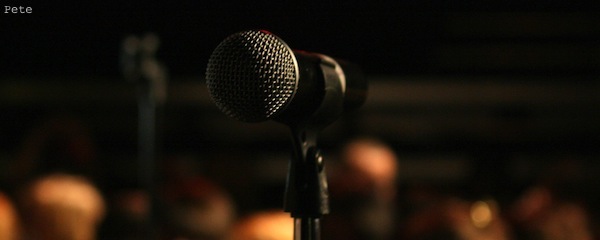
photo by Pete
by Holly Dawson
There’s a stage in front of me. There’s a microphone on the stage. There are lights that make your eyes go funny and a room full of people. There’s a compere who, any minute now, will say my name. All I can think is: Did my friend make it? And is that a hiccup coming on?
Surprisingly, I am not thinking: I. Can’t. Do. This. Run away!
When I found out I was going to be doing two readings in ten days, including a Word Factory Salon at Waterstones in Piccadilly, RUN AWAY was the only thought I had. But, two weeks later, I’m at my first reading, the Rattle Tales compere is saying ‘Holly Dawson’, the applause begins, and I’m not running out the door.
In these two weeks, I pushed through my default ‘ostrich’ position and asked Twitter, Thresholds members and various writer friends for advice on that dreaded act of reading a story at a public event…
1. Prepare in advance
I received lots of great tips on this, the main one being to practice – a lot.
Record yourself on audio (I used Quicktime). Video yourself. Perform it to actual people (or your cat). I found myself mouthing the words in the street on my way to the event. Take advantage of the storms and deliver it to the sea or the hills. Nothing like a galeforce wind to make you project.
Make sure you are happy with the story too, one Rattle Tales member advised. “Nothing worse than thinking ‘this sentence is terrible’ in the middle of reading it to an attentive audience.” (Actually, on my second reading, I didn’t do this. I was still making edits in Waterstones’ back room thirty minutes before. I don’t recommend it, but that kind of pressure really did improve the story, for me.)
Learn from others, too. The Word Factory Vimeo channel, the New Yorker Fiction Podcasts, and videos from Liars’ League, where actors perform the stories, can all be great resources to help you prepare.
2. Mark your manuscript
Your printed page is a tool. Thresholds’ Hannah Radcliffe suggested, “increase the font to a larger size. It means you’re not squinting at the page under pressure, and it helps with nerves if you can clearly see the next line”.
Lynne E. Blackwood kindly offered lots of support with reading, including marking pauses with coloured pen (double slash), writing ‘BREATHE’ in places when you have established the rhythm and where longer pauses are appropriate, and moving a sentence to a new paragraph to make pauses more distinct.
Cherry Potts was also very helpful about adding emphasis to lines: “Learn key sections where you really want to get [the point] over (even if it’s only a sentence) so you can look up safely, then highlight the line you are going back to, so you can find it.”
Through practicing and marking, I found I memorised quite a lot of the story, which was really helpful on both nights.
3. Ask yourself: what do you want from the experience?
Somewhere between stepping onstage for the Rattle Tales reading and starting my story, my inner-performer, who I thought had been killed off in 1999 and buried in a shady corner marked Teenage Years, re-appeared with a vengeance. I was suddenly a bad mime artist after too many coffees, with facial expressions a go-go. I have always admired writers who brought their stories to life, but I hadn’t intended that kind of delivery.
After this reading, I received some wise guidance from writer Paul McVeigh. As Deputy Editor of the Word Factory and Writer at Large for Spread the Word, Paul has seen more than his fair share of readings, from some of the greatest authors in the country. He suggested asking the question: what do you want out of the reading?
“When reading your work, if your goal is to be a published writer rather than, say, a spoken word performer, have faith in your words and focus on a delivery that puts the story first.”
This may also influence which story you choose to read in the first place.
I kept Paul’s words in mind when preparing for my second reading, at the Word Factory. He went on to say:
“One well-placed movement can have a powerful impact at the right place in the story. It can really cement a key scene, phrase, or image in the audience’s mind. Too many actions, however, can be overwhelming and get in the way of us engaging fully with your work.”
Paul spent time with me before the Word Factory event, assessing my story like a choreographer. Where can one purposeful movement emphasise a key point or enhance the listener’s understanding? How can you turn your head or direct your eyes to help the audience ‘see’ the scene you are describing?
4. Things to do right before the event
Opera singer turned writer Cherry Potts gave me the great suggestion of “warming up as you would for singing”. Other people suggested breathing exercises.
Pelt author Catherine McNamara, who came along to the Word Factory event, advocated “a half pint”. In my case, coffee did the trick. Perhaps the drinks-based warning closest to my heart came from Tania Hershman who tweeted in response to my hiccup concern: “I avoid fizzy drinks before reading. Always worried about that…”
I liked the idea, too, of applying bright lipstick before you read, so people can see you speak as well as hear you.
5. Things to do during the reading
Tania Hershman is a seasoned reader, so I noted her advice to “feel the rhythm, the beats, the pauses and leave room for laughs”.
Rattle Tales members gave me advice around speed – it’s impossible to read too slowly, and better to avoid a block of sound. “Don’t be afraid of silence. Use the odd pause as a chance to look up and make eye contact with your audience.”
And what about putting on voices? Liam Hogan suggested:
“Do voices only if you think you can – a good trick is to (in a conversation) look one way for one voice and the other for the other”.
As for the practical details: take water, plant your feet on the ground, don’t worry if you stumble over a word, and if you are offered a lectern take it.
6. Embrace those nerves…
Nerves can be the primary battle. Embrace nerves! They can even make for a good reading. Don’t be too worried about showing emotion, it shows you care. And the over-riding message I got from everyone is to remember that the audience is on your side. They don’t want to find fault with your reading. As someone said: “You might think your leg is about to fall off, it’s shaking so much, but no one else will notice.”
In my case, what helped the most was ‘owning’ the experience in advance of the reading. Be proud. Look forward to it. Tell lots of people. I invited lots of friends and family to the Word Factory event, even though everything in me wanted to keep it to myself. It made me raise my game and treat the reading as more of a celebration than a test.


2 thoughts on “Are You Sitting Comfortably?”
Comments are closed.